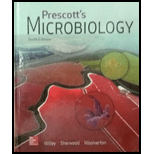
Concept explainers
Biofilms are known to form on surfaces in drinking water distribution networks. It is therefore important to understand how such biofilms develop and how long they last. A recent study followed the development of biofilms populated by the protists in the genera Giardia and Cryptosporidium, as well as a strain of Poliovirus and several bacteriophages. Attachment to, growth within, and detachment from model biofilms were measured in tap water flowing through a special reactor designed to simulate the type of turbulence found in a water distribution network.
Why were the investigators especially interested in biofilm stability? Also, why were they interested in bacteriophages? What special considerations do you think need to be addressed when studying protists with relatively complex life cycles? What method do you think would be most appropriate to detect the protists? What about detecting the viruses?
Read the original paper: Helmi, K., et al. 2008. Interactions of Cryptosporidium parvum, Giardia lamblia, vaccinal poliovirus type 1, and bacteriophages fX174 and MS2 with a drinking water biofilm and a wastewater biofilm. Ann. Rev. Microbiol. 74:2079.
Want to see the full answer?
Check out a sample textbook solution
Chapter 43 Solutions
Prescott's Microbiology
Additional Science Textbook Solutions
Campbell Essential Biology (7th Edition)
Genetics: From Genes to Genomes
HUMAN ANATOMY
Biology: Life on Earth with Physiology (11th Edition)
- Briefly state the physical meaning of the electrocapillary equation (Lippman equation).arrow_forwardExplain in a small summary how: What genetic information can be obtained from a Punnet square? What genetic information cannot be determined from a Punnet square? Why might a Punnet Square be beneficial to understanding genetics/inheritance?arrow_forwardIn a small summary write down:arrow_forward
- Not part of a graded assignment, from a past midtermarrow_forwardNoggin mutation: The mouse, one of the phenotypic consequences of Noggin mutationis mispatterning of the spinal cord, in the posterior region of the mouse embryo, suchthat in the hindlimb region the more ventral fates are lost, and the dorsal Pax3 domain isexpanded. (this experiment is not in the lectures).a. Hypothesis for why: What would be your hypothesis for why the ventral fatesare lost and dorsal fates expanded? Include in your answer the words notochord,BMP, SHH and either (or both of) surface ectoderm or lateral plate mesodermarrow_forwardNot part of a graded assignment, from a past midtermarrow_forward
 Biology: The Dynamic Science (MindTap Course List)BiologyISBN:9781305389892Author:Peter J. Russell, Paul E. Hertz, Beverly McMillanPublisher:Cengage Learning
Biology: The Dynamic Science (MindTap Course List)BiologyISBN:9781305389892Author:Peter J. Russell, Paul E. Hertz, Beverly McMillanPublisher:Cengage Learning Comprehensive Medical Assisting: Administrative a...NursingISBN:9781305964792Author:Wilburta Q. Lindh, Carol D. Tamparo, Barbara M. Dahl, Julie Morris, Cindy CorreaPublisher:Cengage Learning
Comprehensive Medical Assisting: Administrative a...NursingISBN:9781305964792Author:Wilburta Q. Lindh, Carol D. Tamparo, Barbara M. Dahl, Julie Morris, Cindy CorreaPublisher:Cengage Learning Biology Today and Tomorrow without Physiology (Mi...BiologyISBN:9781305117396Author:Cecie Starr, Christine Evers, Lisa StarrPublisher:Cengage Learning
Biology Today and Tomorrow without Physiology (Mi...BiologyISBN:9781305117396Author:Cecie Starr, Christine Evers, Lisa StarrPublisher:Cengage Learning





